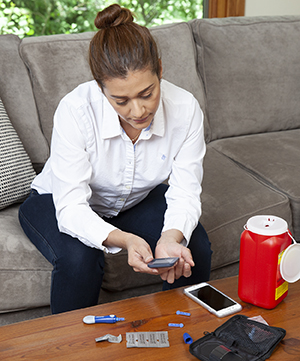Diabetes: Measuring Glucose at Home
Many people with diabetes who use insulin test their blood sugar (glucose) 2 to 4 times a day. If you don’t use insulin, you may need to test it less often. Your healthcare provider can tell you when and how often to check your own level. Be sure to talk about this with your family.

How to test your glucose
Self-checks are often done before meals, after meals, and at bedtime. A family member or friend who knows what needs to be done can help you stick to your schedule. Show your family members how to use the test equipment. Or ask your healthcare provider to show them. Write down the steps and keep the information in a certain place so family members or friends can find it.
The steps are:
-
Put the strip in the meter.
-
Prick your finger with a sharp needle. This needle is called a lancet. In some cases, you can prick a forearm or fleshy part of your hand instead.
-
Put a drop of blood on the tip of the strip when the meter says it's time to do so.
-
Read the glucose number and write it down. Keep a logbook specifically for this information and bring it with you to appointments. Also note anything different about your diet or activities around that time.
At times, you may need to do unscheduled checks. This might be when you are sick with a cold or the flu. These illnesses can cause glucose to change. A family member can remind you to test your blood sugar at least every 4 hours. Or they can do it for you when you are feeling sick. Setting alarms on smartphones or smartwatches can also help remind you to test your blood sugar.
Keeping track of your readings
By tracking your readings, you can see when your blood sugar goes up or down. This helps you make day-to-day choices about balancing your diet, activity, and diabetes medicine. Self-testing also lets you know when to take fast action to treat blood glucose that is very low or high.
If you have trouble keeping your blood sugar in the target range, your healthcare provider can help you. They can try newer ways of measuring your blood sugar with you. One example is continuous glucose monitoring (CGM). CGM alerts users to blood glucose changes. This lets you make quick decisions about diet, exercise, and medicine.
Watching for high blood glucose
At times, you may need to do unscheduled checks. This might be when you are sick with a cold or the flu. These illnesses can cause glucose to change. A family member can remind you to test your blood sugar at least every 4 hours. Or they can do it for you when you are feeling sick.
Check your glucose level if you get symptoms of high blood glucose. These may include:
Tell your healthcare provider if you have any of these symptoms. Also tell them if you have blood sugar levels persistently higher than 200 mg/dL. Also discuss the medicines you take. Some medicines may raise glucose levels.
Watching for low blood glucose
You will need to take steps if your blood sugar dips very low. Symptoms include feeling:
-
Nervous
-
Shaky
-
Lightheaded
-
Sweaty
-
Very tired or confused
-
Hungry
-
Having nightmares
Test your blood sugar at the first sign of these symptoms. This is because a low glucose level can quickly drop even more. If your glucose level falls too low, you may feel confused, act uncooperative, be unable to swallow, have a seizure, or faint. Someone else will need to call for help right away. A family member can also help treat the problem with food. If you can’t swallow, they can give you a shot of glucagon. This is a prescription medicine that raises blood glucose.
If your glucose level is lower than 60 to 70 mg/dL:
-
If you are about to eat a meal, eat a balanced meal as you normally would.
-
If you are between meals, treat low glucose right away. Use glucose tablets, sugar, honey, fruit juice, soda with sugar, or hard candy.
-
Check your glucose every 15 minutes until it rises higher than 70 mg/dL. Or have a family member or friend check it for you. Then eat a regular, balanced meal or snack.
Tell your healthcare provider if you often have low glucose. Your medicines may need to be adjusted.
Getting support
A family member or friend can help you keep your glucose on a more even level. Talk with people close to you about how to help if you have low blood sugar. And if a severe high or low occurs, they can help you handle it quickly and safely. As an extra safety measure, wear a medic alert bracelet or necklace that says you have diabetes.